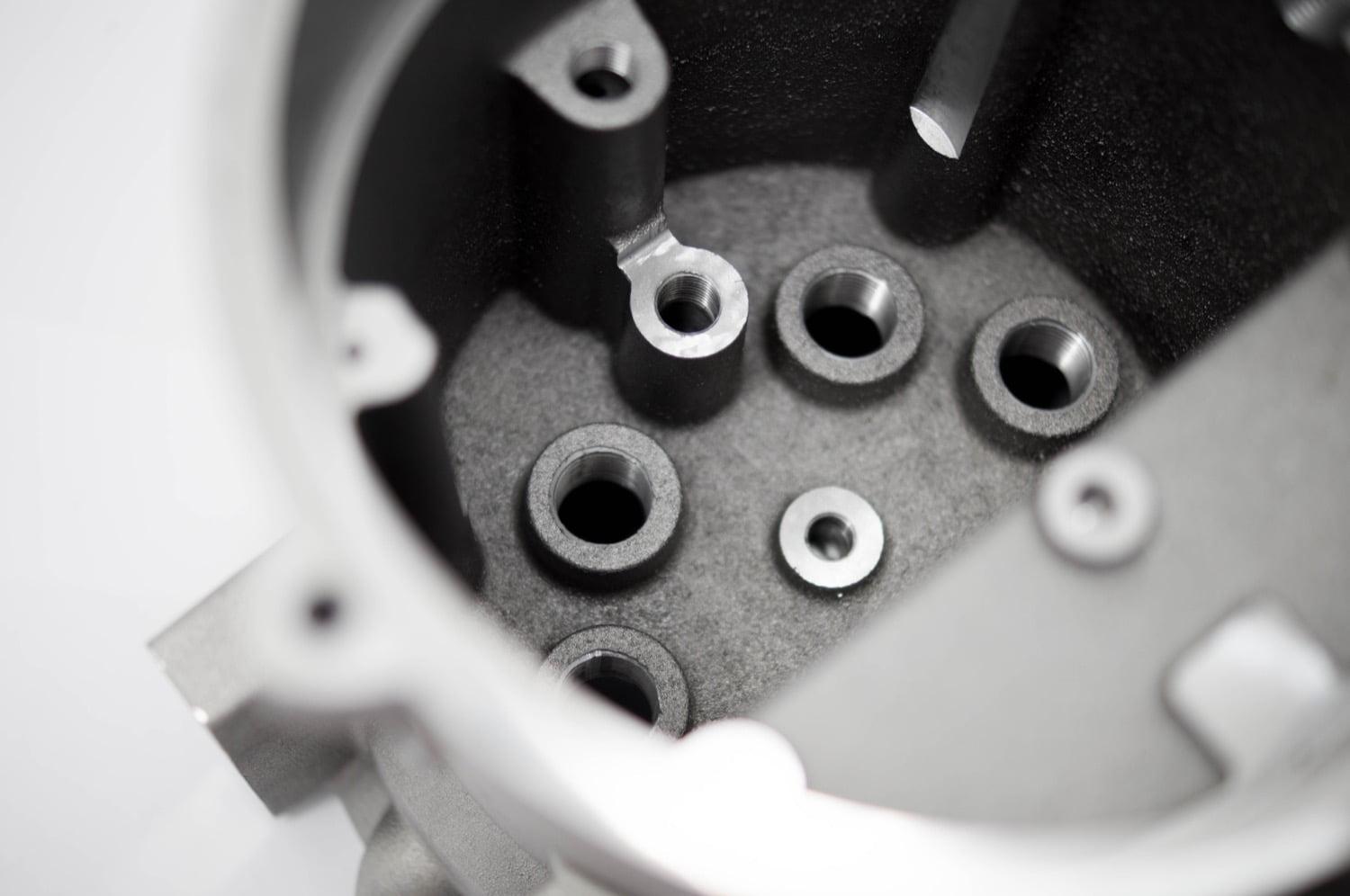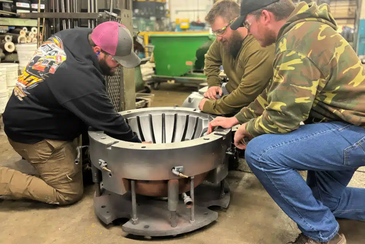The role of Precision aluminum casting in achieving uniformity
Wiki Article
Checking Out the Cutting-edge Processes Behind Modern Light Weight Aluminum Foundry Operations
Modern aluminum factory procedures are undergoing considerable makeover. Automation and AI are improving production methods, improving both effectiveness and accuracy. The integration of 3D printing is streamlining mold development, while sustainability methods are coming to be a lot more vital. Each of these developments plays a crucial duty in redefining the industry. The implications of these changes prolong past simple production performance. What possibilities and challenges lie ahead for light weight aluminum shops in this advancing landscape?The Duty of Automation in Light Weight Aluminum Foundries

Moreover, automation contributes to improved safety standards within the shop setting. By moving harmful jobs to devices, human workers can concentrate on managerial functions and quality assurance, reducing the risk of crashes. Furthermore, information analytics stemmed from automated procedures provide useful understandings right into functional efficiency, resulting in far better decision-making and continual renovation. As the demand for aluminum items expands, the adoption of automation technologies will likely broaden, even more changing the landscape of aluminum factory operations.
Improvements in Spreading Technologies
Current innovations in casting modern technologies are transforming light weight aluminum shop operations. Innovations such as 3D printing assimilation, progressed alloy formulas, and automated procedure optimization are boosting performance and product quality. These developments are pivotal in fulfilling the evolving demands of the industry.3D Printing Integration
Integrating 3D printing modern technology into light weight aluminum foundry operations has actually reinvented standard spreading techniques, improving both efficiency and precision. This innovative strategy permits the rapid production of complex mold and mildews and cores, considerably lowering lead times and material waste. By using additive manufacturing, shops can develop detailed geometries that were formerly challenging or impossible to attain with standard techniques. The versatility of 3D printing additionally enables quick style adjustments, cultivating a much more dexterous production process. In addition, this combination sustains the usage of light-weight frameworks, which is significantly vital in markets such as vehicle and aerospace. As light weight aluminum foundries remain to embrace 3D printing, they position themselves at the leading edge of technological advancement, driving renovations in item top quality and functional abilities.Advanced Alloy Formulations
The growth of sophisticated alloy formulas has significantly improved spreading technologies in aluminum shop operations. These solutions integrate various elements, such as magnesium, copper, and silicon, to boost mechanical homes and thermal resistance. By customizing the make-up of light weight aluminum alloys, makers can achieve details efficiency attributes that fulfill the needs of diverse applications, from vehicle parts to aerospace frameworks. The usage of sophisticated alloys also adds to lowered weight and raised stamina, which are vital consider contemporary engineering. Furthermore, technologies in alloy growth make it possible for better fluidity throughout casting, resulting in enhanced surface area coatings and decreased flaws. In general, progressed alloy formulas represent a significant jump forward, positioning aluminum foundries to fulfill the developing demands of numerous sectors effectively.Automated Refine Optimization
Innovations in casting innovations have actually paved the means for automated procedure improvement in light weight aluminum foundry procedures. By integrating advanced software program and real-time information analytics, shops can now enhance manufacturing procedures and enhance top quality control. Automated systems keep track of variables such as stress, cooling, and temperature level prices, enabling immediate changes that minimize flaws and waste. Furthermore, machine knowing algorithms assess historic performance data to predict excellent settings, consequently increasing efficiency and lowering cycle times. Robotics additionally play a considerable function, handling recurring jobs that enhance security and precision. In general, these innovations not just drive functional efficiency but additionally allow foundries to meet the expanding need for top notch light weight aluminum parts in numerous sectors.Smart Production and Industry 4.0 Combination
The integration of Smart Production and Industry 4.0 within aluminum foundries is transforming functional effectiveness. By leveraging IoT technologies, automation, and robotics, shops can enhance manufacturing processes and lower downtime. Furthermore, data analytics supplies important understandings that boost decision-making and drive continuous improvement.IoT in Foundry Workflow
As makers progressively welcome the Net of Things (IoT), shop procedures are experiencing a transformative change towards smart production and Sector 4.0 combination. Aluminum Foundry. IoT innovations enable real-time information collection and evaluation, improving decision-making procedures and functional efficiency. Sensing units and connected gadgets check tools efficiency, product usage, and environmental problems, permitting for aggressive maintenance and source optimization. This connectivity fosters a more active manufacturing atmosphere, where changes can be made swiftly in action to market demands. Furthermore, IoT facilitates boosted traceability and quality assurance, as data from the whole manufacturing cycle can be conveniently accessed and evaluated. Generally, the assimilation of IoT in shop operations significantly boosts productivity and drives innovation in aluminum production proceduresAutomation and Robotics Assimilation
Automation and robotics integration is transforming light weight aluminum foundry operations by improving performance and precision. This transformative method streamlines procedures such as molding, pouring, and ending up, decreasing human error and boosting output uniformity. By using advanced robotic systems, factories can achieve greater manufacturing rates while preserving rigorous quality standards. Automated systems likewise make it possible for real-time tracking and flexible control, enabling speedy changes to manufacturing parameters. In enhancement, the integration of robotics minimizes labor costs and minimizes security risks related to manual handling of liquified metal. As shops embrace smart manufacturing principles fundamental in Market 4.0, the synergy between automation and robotics strengthens their competitive side, leading the way for lasting growth and innovation in the light weight aluminum spreading market.Data Analytics for Effectiveness
Taking advantage of information analytics considerably boosts performance within light weight aluminum shop operations, lining up with wise production and Industry 4.0 principles. By leveraging real-time data collection and evaluation, foundries can keep an eye on manufacturing processes, forecast equipment failings, and enhance source allotment. This data-driven method helps with insightful decision-making, making it possible for managers to recognize traffic jams and boost workflow. In addition, anticipating analytics empowers foundries to expect market needs, thus reducing waste and making sure prompt product shipment. Combination of data analytics with IoT gadgets enhances functional presence, fostering a positive maintenance culture. Inevitably, carrying out these sophisticated logical strategies not only boosts efficiency yet likewise drives development, placing light weight aluminum foundries to satisfy the developing demands of the market while preserving one-upmanships in a quickly altering landscape.Sustainable Practices in Aluminum Casting
While the light weight aluminum casting industry has commonly faced ecological obstacles, several factories are currently taking on lasting practices to mitigate their impact (Aluminum Casting Company). A significant focus has been on reusing light weight aluminum scrap, which not only minimizes waste however also conserves energy contrasted to key aluminum manufacturing. Cutting-edge melting innovations, such as induction furnaces, improve power efficiency and reduced greenhouse gas emissionsIn addition, foundries are executing closed-loop water systems to reduce water usage and decrease thermal pollution. Using eco-friendly binders in mold-making procedures is obtaining grip, additional decreasing hazardous exhausts.
In addition, some facilities are investing in sustainable power resources to power procedures, lining up with global sustainability objectives. By incorporating these techniques, the aluminum spreading industry is progressing toward an extra environmentally responsible future, demonstrating that financial development can exist together with eco-friendly stewardship - Precision aluminum casting. These initiatives show a dedication to sustainability and the significance of ecological liability in production
Quality Assurance Innovations
As the light weight aluminum casting sector breakthroughs towards sustainability, the relevance of quality assurance developments comes to be progressively noticeable. Modern aluminum foundries are embracing advanced innovations to enhance their high quality assurance processes. Strategies such as real-time tracking and information analytics permit suppliers to identify flaws and incongruities early in the production cycle. Applying automated assessment systems geared up with device discovering formulas warranties that products fulfill strict quality standards while reducing human error.Furthermore, the combination of non-destructive screening approaches, such as radiographic and ultrasonic assessments, supplies deeper insights into the honesty of castings without harming the material. These innovations not just enhance product integrity however likewise decrease waste, straightening with sustainability goals. Furthermore, the fostering of standardized high quality structures assists streamline operations throughout different factories, ensuring consistency in result. Collectively, these developments are reshaping quality assurance, cultivating a society of quality within the aluminum spreading sector.
Future Fads in Aluminum Shop Procedures
What technologies exist ahead for aluminum foundry procedures? The future of aluminum foundries is positioned for improvement through developments in automation, expert system, and lasting methods. The combination of robotics and automated systems is anticipated to enhance efficiency and accuracy in the spreading processes, reducing human mistake and labor expenses. Additionally, AI-driven analytics will certainly allow real-time surveillance and predictive maintenance, optimizing operational efficiency and reducing downtime.Sustainability remains a focal factor, with factories significantly embracing environmentally friendly methods, such as using recycled light weight aluminum and establishing low-emission melting technologies. Technologies in 3D printing are also prepared for to revolutionize mold-making, enabling complex geometries and minimized product waste. As the industry embraces digitalization, data-driven decision-making will certainly come to be crucial, enabling factories to react promptly to market needs. Collectively, these fads promise to redefine aluminum shop procedures, making them extra effective, sustainable, and versatile to future challenges.

Frequently Asked Inquiries
What Precaution Are Applied in Aluminum Foundry Workflow?
Aluminum foundry procedures implement various precaution, including individual safety equipment, ventilation systems to manage fumes, regular safety and security training, emergency situation feedback plans, and strict monitoring of temperature and devices to avoid crashes and guarantee worker security.Exactly How Do Shops Handle Labor Force Training for New Technologies?

What Products Are Generally Reused in Light Weight Aluminum Foundries?
Aluminum factories frequently reuse scrap light weight aluminum, consisting of post-consumer products like beverage containers, automotive parts, and building materials. This recycling process minimizes waste and saves sources, adding to a more sustainable aluminum manufacturing industry.How Does Aluminum Spreading Influence the Atmosphere?
Light weight aluminum casting influences the setting via energy-intensive processes, greenhouse gas discharges, and possible local contamination. Improvements in recycling and sustainable practices can mitigate these effects, promoting a more green method to light weight aluminum production.What Are the Normal Lead Times for Aluminum Casting Projects?
Normal lead times for aluminum casting jobs differ substantially, typically varying from 2 to 6 weeks. Elements influencing these timelines consist of complexity, order size, and product accessibility, influencing overall production schedules in factory operations.
Automation significantly plays an important function in light weight aluminum foundries, enhancing performance and accuracy in the production procedure. Advancements in casting technologies have actually paved the method for automated process enhancement in aluminum factory procedures. Utilizing information analytics greatly enhances efficiency within light weight aluminum factory procedures, lining up with wise production and Industry 4.0 concepts. A significant focus has been on recycling Aluminum Casting Company light weight aluminum scrap, which not just minimizes waste but likewise conserves power contrasted to key aluminum manufacturing. Aluminum factories commonly reuse scrap light weight aluminum, including post-consumer products like drink containers, auto components, and construction materials.
Report this wiki page